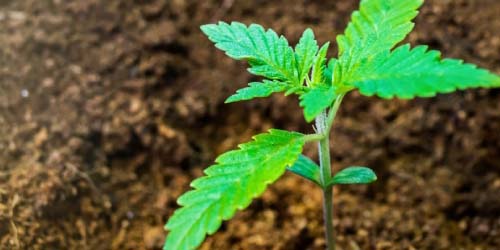
Cultivating weed on coconut is a very popular form of hydrocultivation. This involves using coconut fibre as compost in place of soil. Are you providing a healthy medium by means of the right watering and fertilizer? Then coconut compost can be an incredibly good soil for your weed plant. With a high yield and top-quality weed as your reward. Are you curious about how cultivation on coconut works? You can find all the information, tips, tricks and requirements right here!
What is Hydroponics or Hydroculture?
Cultivating on coconut is a form of hydrocultivation – also referred to as hydroculture. In hydrocultivation you use a special medium in which the roots of your plants are continuously immersed in water or always surrounded by water. All without soil. In addition to the fact that you can leave the roots of your plant completely in the water with a complex system, you can also work with mediums such as clay granules (hydrogranules), rock wool and coconut fibre without too much effort. The advantage of these mediums is that they are very aerated, so there is more room for oxygen and therefore you don't need an air stone for the oxygen. This is of enormous benefit to the plant. The roots can go about their business nicely and grow freely without you needing a lot of material. When combined with the right watering and fertilizers, a hydroculture medium is the perfect medium for weed plants.
The roots of hydroponic plants – as they are called when you cultivate with a hydro medium – develop such that they can absorb enough oxygen from water and fertilizers without using soil. As a result they look a bit different from the roots of weed plants cultivated in normal soil or compost. The root system of a hydroponic weed plant often looks quite spectacular.
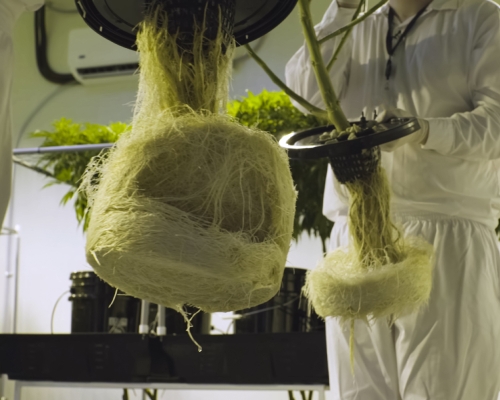
Root system in hydroculture (clay granules)
Weed on Coconut Fibre or Coconut Compost: The Advantages
Coconut fibres or coconut compost comes from the husks of real coconuts. Compressed coconut fibre serves as a great airy medium for weed plants. Coconut compost contains approximately 25 to 30% air so the roots of your weed plant can absorb enough oxygen and have plenty of room to grow. The pH value is an important factor in cultivating weed on coconut fibre or coconut compost. That is also the case with cultivating in soil but because you give a lot of water and your roots are mainly surrounded by water you need to pay extra attention to this. Coconut fibres often have a stable pH value between 6.5 and 7.0. The ideal pH value for hydro cultivation on coconut fibre, on the other hand, is somewhat lower than for cultivation on soil. Namely around 5.8 and 6.0. Adjust the pH value of your feed water with pH min and check the values every now and then. You can then expect great results.
In contrast to processed soil, pure coconut compost contains no nutrients or nutrient reserve in its own right. There is thus less chance of leaf problems and nasty diseases but you do have to provide fertiliser from the very moment your plants go in the coconut. Coconut also absorbs a lot more water than soil so overwatering is less of a problem. As this is a common problem facing growers, that alone could be a good reason to have a go at cultivating weed on coconut. But there is a flip side to this story. Coconut compost or coconut fibres absolutely must not be allowed to dry out during the cultivation. That can damage your medium and your roots and then your cultivation is doomed to failure. So yes, better to give too much than too little water. So? Once they dip their toes in the water, the ladies have to stay in the water.
Advantages of cultivating weed on coconut:
- Cultivating weed on coconut is a very popular form of hydroculture.
- Greatly resembles cultivating with soil
- Coconut fibres form a highly aerated medium for your weed plants
- There is plenty of space for your root system to grow and absorb oxygen
- A large root system results in a successful and potentially faster growing phase
- Highly suited to fast flowering
- It’s difficult to overwater coconut compost
- Doesn’t contain any nutrients / nutrient reserve of its own – you have to provide fertilizer and completely manage the EC value yourself
- Less chance of diseases and leaf problems
- Only one type of fertilizer during the entire cultivation
- Sustainable: you can reuse coconut fibres
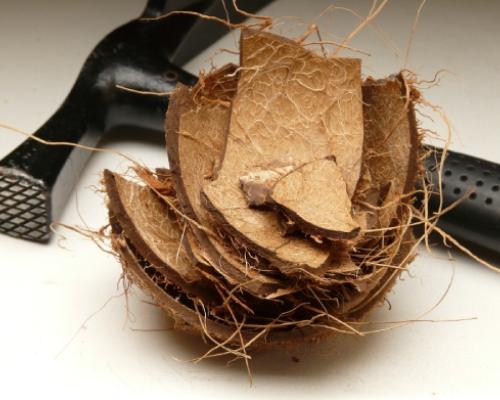
Coconut fibres come from the husks of coconuts
Cultivating Weed On Coconut: Various Options
Cultivating weed on coconut doesn’t have to look difficult. In actual fact it’s up to you how difficult you want to make it. That’s because you have various options when it comes to coconut compost.
- You could decide to cultivate on 100% coconut fibre. This is pure hydroculture. It has all the advantages that were mentioned previously. Pure coconut compost may work out expensive. It’s also a rather laborious way of cultivating because you have to give a lot of water and closely monitor the pH and EC values. You can put this medium straight into your pot and get cultivating.
- You can also opt for a mixture of coconut fibre and clay granules (hydrogranules). Plagron supplies large bags with a combined mixture of these mediums. The mix is 60% coconut fibre and 40% hydrogranules. This is a balanced mix that is really suited to hydrocultivation. You might say that the mix combines the best of two mediums. You still need to give plenty of water and keep a close watch on nutritional values.
- Our favourite option is cultivation using Plagron Cocos Brix. These are buffered and compressed bricks of coconut fibre that get a lot bigger when you add water. This gives you an immediate pure, natural and pH-stable medium for your weed plant. Plagron Cocos Brix are treated with calcium and rinsed with water. In combination with Plagron’s special coconut fertilizer, you have an outstanding medium for any weed plant. Especially for fast flowering weed plants. Whereas ordinary coconut fibre or coconut compost absorbs little water, Cocos Brix retain water well. This means you don’t have to give as much water but still keep the advantages of cultivation on coconut. Moreover, it’s easier on your wallet.
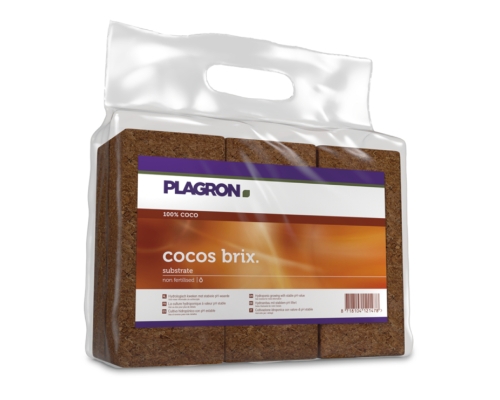
Plagron Cocos Brix
Cultivating Weed on Coconut: Water and Fertilizer
If you have a go at cultivating weed on coconut (completely with Plagron Cocos Brix), then as far as watering is concerned it’s not much different from normal. The most important thing is not to allow the coconut compost – whichever type it is – to dry out. That would damage your roots or even kill them off which is the last thing you want to happen. So make sure you monitor the weed plant and the medium closely. Daily watering is a must. Needless to say, good drainage / holes in the bottom of the pot and a constant pH value are also musts. If you manage these properly, then it’s quite difficult to overwater a coconut fibre medium. But don’t disregard this because much too much is obviously never good.
In short: make sure the medium never dries out, keep checking the pH value and provide good drainage. This demands both time and attention.
Fertilizer for coconut compost? Plagron Coconut Fertilizer
One big advantage of cultivating weed on coconut is it simplifies the fertilizer issue. If you cultivate with Plagron Coconut fertilizer, then you only have to use one type of fertilizer throughout the entire cultivation. No messing around with stimulators, plant boosters and other paraphernalia.
Take . This is a twin-component fertilizer specially developed for hydrocultivation on coconut compost. When you combine the 2 bottles of weed fertilizer together, your weed plants get all the nutrients they need. They get a balanced mix of fertilizers during both the growing and flowering phases. They simply don’t need anything else. If you monitor the watering carefully and use this Plagron coconut fertilizer, you can rely on having a low and correct EC value. You do have to buy both bottles. Cocos A doesn’t work without Cocos B, and vice versa.
Important: always check the pH value of the fertilizer water after adding the Plagron coconut fertilizer. Then you can be sure you have the correct value.
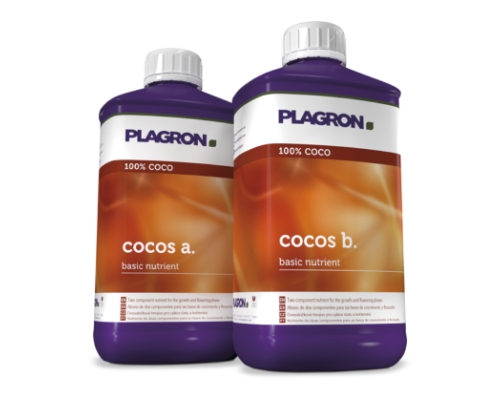
Cocos A&B from Plagron – Plant fertilizer specially for hydrocultivation using coconut compost
Other forms of Hydroculture
Growing weed on coconut fibre is not the only form of hydroculture. For example, you can also cultivate with rock wool or clay granules / hydrogranules. These forms of hydroculture are associated with other factors you have to consider during the cultivation. They are definitely not the same as cultivating weed on coconut. So read up on them properly before starting. One thing is the same though: you have to give fertilizer. Other forms of hydroculture can make use of . Check out the information on the product pages for more information about these forms of hydrocultivation.
Are you looking for more tips on cultivation? Then take a look at our special blog page for cultivating weed.